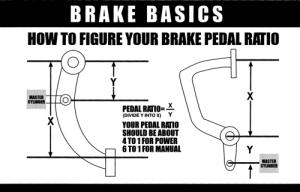Properly operating brakes are essential for safety. One thing that would make your brakes UNSAFE is the inability to depress the pedal because it is way too stiff! Fortunately, if you know the right places to check, a hard brake pedal is something you might be able to troubleshoot and fix yourself. To help you out, let’s continue this 4-part series on diagnosing and solving issues of brakes that can’t be applied because the pedal is too stiff to compress!
Previously in this series, we addressed a hard brake caused by a tripped pressure differential valve, as well as insufficient vacuum pressure creating a too-hard brake pedal. Here in part three, we take up pedal ratio – essentially the relationship between your brake pedal length and where it pivots – an issue that comes to light with some regularity when drivers experience a hard brake.
Pedal ratio is overlooked by most people as a potential root cause of a stiff pedal. This is less of a problem with later muscle cars and more of a problem in earlier street rods when the booster/master is mounted under the vehicle. However, pedal ratio can be as big a problem in either case, so it must be considered as a potential cause for a hard brake pedal.
Pedal ratio refers to the relationship between the pedal’s pivot points and the length of the brake pedal. The pedal is used as a lever to apply motion to the booster (or directly to the master cylinder if your car does not have a power booster) based on the length of the pedal. If the pedal ratio is incorrect by as little as 1/4”, this can allow too little pushrod to move through to the booster. This, in turn prevents the booster from moving the piston into the master cylinder. The hard pedal you are feeling is actually the bottoming out of the pedal and its movement but leaving stroke within the master cylinder and therefore brake pressure at the wheels.
Correcting the pedal ratio can be sometimes difficult if it means moving the pedal pivot. The corrective action though can sometimes be as simple as relocating the connection point of the pushrod between the pedal and the booster. For reference, a power system should have a pedal ratio of 4:1 while a manual brake system should be 6:1. Follow this link to our website for more info on calculating pedal ratio.
Pedal ratio is not one of the more obvious causes of hard brake pedals. This is particularly true if the brackets and pedals are all factory installs. However, in cases where modifications have been made, this definitely may be an area worth looking into. Unfortunately during some brake modification processes, pedal ratio is not taken into consideration. After having new brake components installed you will need to reconfigure the pedal ratio to ensure optimum braking performance. Use the tips above or consult a professional mechanic. And, as always, if you need brake components or a brake conversion kit, get a hold of us! At Master Power, we are always ready to help.

